Zyxel NBG6615 User Manual

User’s Guide
NBG6615
AC1200 MU-MIMO Dual-Band Wireless Gigabit Router
Default Login Details |
|
|
|
Version 1.0 Edition 1, 06/2019 |
||||||||||||||||||||
|
|
|
|
|
|
|
|
|
|
|
||||||||||||||
Login URL |
http://192.168.212.1 (Router mode) |
|
|
|
|
|
|
|
|
|||||||||||||||
|
|
|
|
|
http://192.168.2.1 (AP mode) |
|
|
|
|
|
|
|
|
|||||||||||
|
|
|
|
|
|
|
|
|
|
|
|
|
|
|
|
|
|
|
||||||
User Name |
|
|
|
|
|
|
|
|
admin |
|
|
|
|
|
|
|
|
|||||||
|
|
|
|
|
|
|
|
|
|
|
|
|
||||||||||||
Password |
1234 |
|
|
|
|
|
|
|
|
|
|
|
||||||||||||
|
|
|
|
|
|
|
|
|
|
|
|
|
|
|
|
|
|
|
|
|
|
|
|
|
|
|
|
|
|
|
|
|
|
|
|
|
|
|
|
|
|
|
|
|
|
|
|
|
|
|
|
|
|
|
|
|
|
|
|
|
|
|
|
|
|
|
|
|
|
|
|
|
|
|
|
|
|
|
|
|
|
|
|
|
|
|
|
|
|
|
|
|
|
|
|
|
|
|
|
|
|
|
|
|
|
|
|
|
|
|
|
|
|
|
|
|
|
|
|
|
|
|
|
|
|
|
|
|
|
|
|
|
|
|
|
|
|
|
|
|
|
|
|
|
|
|
|
|
|
|
|
|
|
|
|
|
|
|
|
|
|
|
|
|
|
|
|
|
|
|
|
|
|
|
|
|
|
|
|
|
|
|
|
|
|
|
|
|
|
|
|
|
|
|
|
|
|
|
|
|
|
|
|
|
|
|
|
|
|
|
|
|
|
|
|
|
|
|
|
|
|
|
|
|
|
|
|
|
|
|
|
|
|
|
|
|
|
|
|
|
|
|
|
|
|
|
|
|
|
|
|
|
|
|
|
|
|
|
|
|
|
|
|
|
|
|
|
|
|
|
|
|
|
|
|
|
|
|
|
|
|
|
|
|
|
|
|
|
|
|
|
|
|
|
|
|
|
|
|
|
|
|
|
|
|
|
|
|
|
|
|
|
|
|
|
|
|
|
|
|
|
|
|
|
|
|
|
|
|
|
|
|
|
|
|
|
|
|
|
|
|
|
|
|
|
|
|
|
|
Copyright © 2019 Zyxel Communications Corporation

IMPORTANT!
READ CAREFULLY BEFORE USE.
KEEP THIS GUIDE FOR FUTURE REFERENCE.
Screenshots and graphics in this book may differ slightly from what you see due to differences in release versions or your computer operating system. Every effort has been made to ensure that the information in this manual is accurate.
Related Documentation
•Quick Start Guide
The Quick Start Guide shows how to connect the NBG6615 and access the Web Configurator.
•More Information
Go to support.zyxel.com to find other information on the NBG6615.
NBG6615’s User’s Guide
2

|
Contents Overview |
|
Contents Overview |
User’s Guide ...................................................................................................................................... |
10 |
Introduction ........................................................................................................................................... |
11 |
The Web Configurator ......................................................................................................................... |
16 |
Connection Wizard .............................................................................................................................. |
20 |
Modes .................................................................................................................................................... |
28 |
Tutorials .................................................................................................................................................. |
39 |
Technical Reference ........................................................................................................................ |
53 |
Wireless LAN .......................................................................................................................................... |
54 |
WAN ....................................................................................................................................................... |
67 |
LAN ......................................................................................................................................................... |
77 |
DHCP Server .......................................................................................................................................... |
81 |
Network Address Translation ............................................................................................................... |
85 |
Dynamic DNS ........................................................................................................................................ |
94 |
Static Route ........................................................................................................................................... |
96 |
Firewall ................................................................................................................................................... |
99 |
Content Filter ....................................................................................................................................... |
104 |
Remote Management ....................................................................................................................... |
106 |
Universal Plug-and-Play (UPnP) ......................................................................................................... |
109 |
Bandwidth MGMT ............................................................................................................................... |
117 |
System .................................................................................................................................................. |
120 |
Logs ...................................................................................................................................................... |
123 |
Tools ...................................................................................................................................................... |
125 |
Sys OP Mode ....................................................................................................................................... |
130 |
Language ............................................................................................................................................ |
132 |
Troubleshooting and Appendices ................................................................................................. |
133 |
Troubleshooting .................................................................................................................................. |
134 |
NBG6615’s User’s Guide
3

|
Table of Contents |
|
|
|
Table of Contents |
Contents Overview ............................................................................................................................. |
3 |
|
Table of Contents ................................................................................................................................. |
4 |
|
Part I: User’s Guide.......................................................................................... |
10 |
|
Chapter 1 |
|
|
Introduction ........................................................................................................................................ |
11 |
|
1.1 |
Overview ......................................................................................................................................... |
11 |
1.2 |
Securing the NBG6615 ................................................................................................................... |
12 |
1.3 |
LEDs .................................................................................................................................................. |
13 |
1.4 |
The WPS Button ............................................................................................................................... |
13 |
|
1.4.1 Using the WPS Button ............................................................................................................ |
14 |
1.5 |
Reboot/Reset Button ...................................................................................................................... |
14 |
1.6 |
Wall Mounting ................................................................................................................................. |
14 |
Chapter 2 |
|
|
The Web Configurator........................................................................................................................ |
16 |
|
2.1 |
Overview ......................................................................................................................................... |
16 |
2.2 |
Accessing the Web Configurator ................................................................................................. |
16 |
2.3 |
Resetting the NBG6615 .................................................................................................................. |
18 |
Chapter 3 |
|
|
Connection Wizard ............................................................................................................................ |
20 |
|
3.1 |
Wizard Setup ................................................................................................................................... |
20 |
|
3.1.1 Static IP Connection ............................................................................................................. |
22 |
|
3.1.2 DHCP Client ........................................................................................................................... |
22 |
|
3.1.3 PPPoE Connection ................................................................................................................ |
23 |
|
3.1.4 PPTP Connection ................................................................................................................... |
24 |
Chapter 4 |
|
|
Modes ................................................................................................................................................. |
|
28 |
4.1 |
Overview ......................................................................................................................................... |
28 |
4.2 |
Setting your NBG6615 to Router Mode ........................................................................................ |
29 |
|
4.2.1 Status Screen (Router Mode) .............................................................................................. |
29 |
|
4.2.2 Router Mode Navigation Panel .......................................................................................... |
33 |
4.3 Setting your NBG6615 to AP Mode ............................................................................................... |
34 |
|
|
4.3.1 Status Screen (AP Mode) ..................................................................................................... |
35 |
|
NBG6615’s User’s Guide |
|
4

|
Table of Contents |
|
|
4.3.2 AP Navigation Panel ............................................................................................................. |
37 |
Chapter 5 |
|
|
Tutorials ............................................................................................................................................... |
|
39 |
5.1 |
Overview ......................................................................................................................................... |
39 |
5.2 |
How to Connect to the Internet from an AP ............................................................................... |
39 |
5.3 |
Configure Wireless Security Using WPS on both your NBG6615 and Wireless Client ............... |
39 |
|
5.3.1 Push Button Configuration ................................................................................................... |
40 |
|
5.3.2 PIN Configuration .................................................................................................................. |
41 |
5.4 |
Enable and Configure Wireless Security without WPS on your NBG6615 ................................. |
43 |
|
5.4.1 Configure Your Wireless Client ............................................................................................. |
44 |
5.5 |
Using Multiple SSIDs on the NBG6615 ........................................................................................... |
46 |
|
5.5.1 Configuring Security Settings of Multiple SSIDs .................................................................. |
47 |
5.6 |
Installing UPnP in Windows 7 Example .......................................................................................... |
50 |
5.7 Using Bandwidth Management on the NBG6615 ...................................................................... |
50 |
|
Part II: Technical Reference........................................................................... |
53 |
|
Chapter 6 |
|
|
Wireless LAN ....................................................................................................................................... |
54 |
|
6.1 |
Overview ......................................................................................................................................... |
54 |
6.2 What You Can Do .......................................................................................................................... |
54 |
|
6.3 What You Should Know ................................................................................................................. |
55 |
|
|
6.3.1 Wireless Security Overview ................................................................................................... |
55 |
|
6.3.2 MBSSID .................................................................................................................................... |
55 |
|
6.3.3 MAC Address Filter ................................................................................................................ |
56 |
|
6.3.4 Encryption .............................................................................................................................. |
56 |
|
6.3.5 WPS ......................................................................................................................................... |
56 |
6.4 |
General Wireless LAN Screen ....................................................................................................... |
57 |
|
6.4.1 No Security ............................................................................................................................. |
58 |
|
6.4.2 WPA2-PSK or WPA-PSK/WPA2-PSK ....................................................................................... |
58 |
6.5 |
MAC Filter ........................................................................................................................................ |
59 |
6.6 |
Wireless LAN Advanced Screen ................................................................................................... |
60 |
6.7 |
WPS Screen ..................................................................................................................................... |
61 |
6.8 |
WPS Station Screen ........................................................................................................................ |
63 |
6.9 |
Scheduling Screen ......................................................................................................................... |
63 |
6.10 MBSSID Screen .............................................................................................................................. |
64 |
|
Chapter 7 |
|
|
WAN .................................................................................................................................................... |
|
67 |
7.1 |
Overview ......................................................................................................................................... |
67 |
|
NBG6615’s User’s Guide |
|
5

Table of Contents |
|
7.2 What You Need To Know .............................................................................................................. |
67 |
7.2.1 Configuring Your Internet Connection ............................................................................... |
67 |
7.3 Internet Connection Screen .......................................................................................................... |
68 |
7.3.1 Static IP ................................................................................................................................... |
68 |
7.3.2 DHCP Client ........................................................................................................................... |
70 |
7.3.3 PPPoE Connection ................................................................................................................ |
71 |
7.3.4 PPTP Connection ................................................................................................................... |
73 |
7.4 Advanced Screen .......................................................................................................................... |
75 |
Chapter 8 |
|
LAN ...................................................................................................................................................... |
77 |
8.1 Overview ......................................................................................................................................... |
77 |
8.2 What You Need To Know .............................................................................................................. |
77 |
8.2.1 IP Address and Subnet Mask ............................................................................................... |
78 |
8.2.2 DNS Server Address Assignment .......................................................................................... |
78 |
8.2.3 IP Pool Setup .......................................................................................................................... |
79 |
8.2.4 LAN TCP/IP ............................................................................................................................. |
79 |
8.3 LAN IP Screen .................................................................................................................................. |
79 |
Chapter 9 |
|
DHCP Server........................................................................................................................................ |
81 |
9.1 Overview ......................................................................................................................................... |
81 |
9.2 What You Can Do .......................................................................................................................... |
81 |
9.3 What You Need To Know .............................................................................................................. |
81 |
9.4 General Screen ............................................................................................................................... |
81 |
9.5 Static DHCP Screen ..................................................................................................................... |
82 |
9.6 Client List Screen ............................................................................................................................. |
83 |
Chapter 10 |
|
Network Address Translation ............................................................................................................ |
85 |
10.1 Overview .................................................................................................................................... |
85 |
10.2 What You Can Do ........................................................................................................................ |
85 |
10.2.1 What You Need To Know ................................................................................................... |
86 |
10.3 General NAT Screen ..................................................................................................................... |
87 |
10.4 NAT Application Screen ............................................................................................................. |
88 |
10.5 Port Triggering Screen .................................................................................................................. |
90 |
10.6 Technical Reference .................................................................................................................... |
91 |
10.6.1 NAT Port Forwarding: Services and Port Numbers ........................................................... |
92 |
10.6.2 NAT Port Forwarding Example ........................................................................................... |
92 |
10.6.3 Trigger Port Forwarding ...................................................................................................... |
92 |
10.6.4 Trigger Port Forwarding Example ...................................................................................... |
93 |
10.6.5 Two Points To Remember About Trigger Ports ................................................................. |
93 |
NBG6615’s User’s Guide |
|
6

|
Table of Contents |
|
Chapter 11 |
|
|
Dynamic DNS ..................................................................................................................................... |
94 |
|
11.1 |
Overview ...................................................................................................................................... |
94 |
11.2 Dynamic DNS Screen ................................................................................................................. |
94 |
|
Chapter 12 |
|
|
Static Route......................................................................................................................................... |
96 |
|
12.1 |
Overview .................................................................................................................................... |
96 |
12.2 |
IP Static Route Screen ................................................................................................................. |
96 |
Chapter 13 |
|
|
Firewall ................................................................................................................................................ |
|
99 |
13.1 |
Overview ..................................................................................................................................... |
99 |
13.2 What You Can Do ........................................................................................................................ |
99 |
|
13.3 What You Need To Know .......................................................................................................... |
100 |
|
13.3.1 About the NBG6615 Firewall ............................................................................................ |
100 |
|
13.3.2 VPN Pass Through Features .............................................................................................. |
100 |
|
13.4 |
General Firewall Screen .......................................................................................................... |
100 |
13.5 |
Services Screen ........................................................................................................................ |
101 |
13.6 |
MAC Filter Screen ....................................................................................................................... |
102 |
Chapter 14 |
|
|
Content Filter .................................................................................................................................... |
104 |
|
14.1 |
Overview ..................................................................................................................................... |
104 |
14.2 What You Can Do ...................................................................................................................... |
104 |
|
14.3 |
Filter Screen .............................................................................................................................. |
104 |
Chapter 15 |
|
|
Remote Management ..................................................................................................................... |
106 |
|
15.1 |
Overview ..................................................................................................................................... |
106 |
15.1.1 Remote Management Limitations .................................................................................. |
107 |
|
15.1.2 Remote Management and NAT ..................................................................................... |
107 |
|
15.1.3 System Timeout .................................................................................................................. |
107 |
|
15.2 WWW Screen ........................................................................................................................... |
107 |
|
Chapter 16 |
|
|
Universal Plug-and-Play (UPnP)...................................................................................................... |
109 |
|
16.1 |
Overview .................................................................................................................................... |
109 |
16.2 What You Need to Know ........................................................................................................... |
109 |
|
16.3 |
Configuring UPnP ........................................................................................................................ |
110 |
16.4 |
Installing UPnP in Windows 7 Example ...................................................................................... |
110 |
16.4.1 Using UPnP in Windows XP Example ................................................................................ |
112 |
|
16.4.2 Web Configurator Easy Access ....................................................................................... |
114 |
|
|
NBG6615’s User’s Guide |
|
7

|
|
Table of Contents |
Chapter 17 |
|
|
Bandwidth MGMT............................................................................................................................. |
117 |
|
17.1 |
Overview ..................................................................................................................................... |
117 |
17.2 What You Can Do ...................................................................................................................... |
117 |
|
17.3 What You Need To Know .......................................................................................................... |
117 |
|
17.4 Bandwidth MGMT Screen ......................................................................................................... |
117 |
|
17.5 Advanced Screen ..................................................................................................................... |
118 |
|
Chapter 18 |
|
|
System............................................................................................................................................... |
|
120 |
18.1 |
Overview ..................................................................................................................................... |
120 |
18.2 What You Can Do ...................................................................................................................... |
120 |
|
18.3 |
System General Screen ............................................................................................................ |
120 |
18.4 |
Time Setting Screen .................................................................................................................... |
121 |
Chapter 19 |
|
|
Logs ................................................................................................................................................... |
|
123 |
19.1 |
Overview ..................................................................................................................................... |
123 |
19.2 What You Need to Know ........................................................................................................... |
123 |
|
19.3 View Log Screen ......................................................................................................................... |
123 |
|
Chapter 20 |
|
|
Tools .................................................................................................................................................. |
|
125 |
20.1 |
Overview ..................................................................................................................................... |
125 |
20.2 What You Can Do ...................................................................................................................... |
125 |
|
20.3 |
Firmware Upload Screen ........................................................................................................... |
125 |
20.4 |
Configuration Screen ................................................................................................................. |
127 |
20.4.1 Backup Configuration ...................................................................................................... |
127 |
|
20.4.2 Restore Configuration ...................................................................................................... |
128 |
|
20.4.3 Back to Factory Defaults .................................................................................................. |
128 |
|
20.5 |
Restart Screen ............................................................................................................................. |
129 |
Chapter 21 |
|
|
Sys OP Mode .................................................................................................................................... |
130 |
|
21.1 |
Overview ..................................................................................................................................... |
130 |
21.2 |
General Screen ........................................................................................................................... |
130 |
Chapter 22 |
|
|
Language ......................................................................................................................................... |
|
132 |
22.1 Language Screen ....................................................................................................................... |
132 |
|
NBG6615’s User’s Guide
8

Table of Contents |
|
Part III: Troubleshooting and Appendices.................................................. |
133 |
Chapter 23 |
|
Troubleshooting................................................................................................................................ |
134 |
23.1 Power, Hardware Connections, and LEDs ............................................................................... |
134 |
23.2 NBG6615 Access and Login ...................................................................................................... |
135 |
23.3 Internet Access ........................................................................................................................... |
136 |
23.4 Resetting the NBG6615 to Its Factory Defaults ........................................................................ |
137 |
23.5 Wireless Problems ........................................................................................................................ |
138 |
Appendix A IP Addresses and Subnetting.................................................................................... |
139 |
Appendix B Pop-up Windows, JavaScripts and Java Permissions ............................................ |
148 |
Appendix C Setting Up Your Computer’s IP Address.................................................................. |
157 |
Appendix D Wireless LANs .............................................................................................................. |
184 |
Appendix E Common Services ...................................................................................................... |
197 |
Appendix F Legal Information ....................................................................................................... |
200 |
Appendix G Customer Support ..................................................................................................... |
207 |
Index ................................................................................................................................................. |
213 |
NBG6615’s User’s Guide
9

PART I
User’s Guide
10
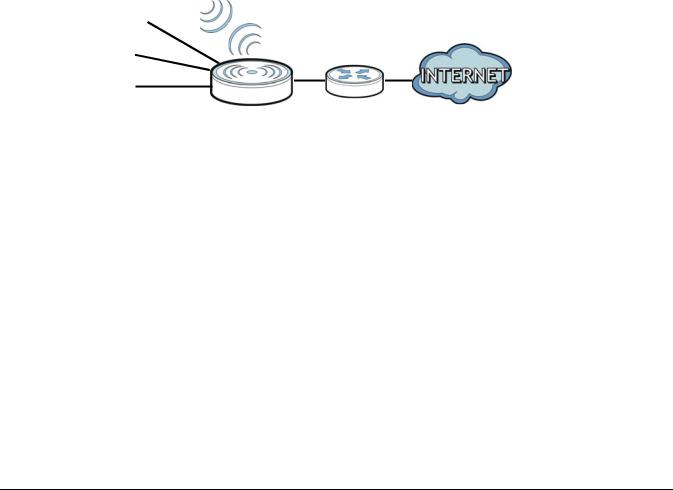
CHAPTER 1
Introduction
1.1 Overview
The NBG6615 extends the range of your existing wired network without additional wiring, providing easy network access to mobile users.
You can create the following connections using the NBG6615:
•LAN. You can connect network devices via the Ethernet ports of the NBG6615 so that they can communicate with each other and access the Internet.
•WLAN. Wireless clients can connect to the NBG6615 to access network resources.
•WAN. Connect to a broadband modem/router for Internet access.
Figure 1 NBG6615 Network
WLAN
LAN1
LAN2 |
WAN |
LAN3
LAN4
You can set up the NBG6615 with other IEEE 802.11b/g/n compatible devices in one of the following device modes:
•Router
•Access Point
NBG6615’s User’s Guide
11
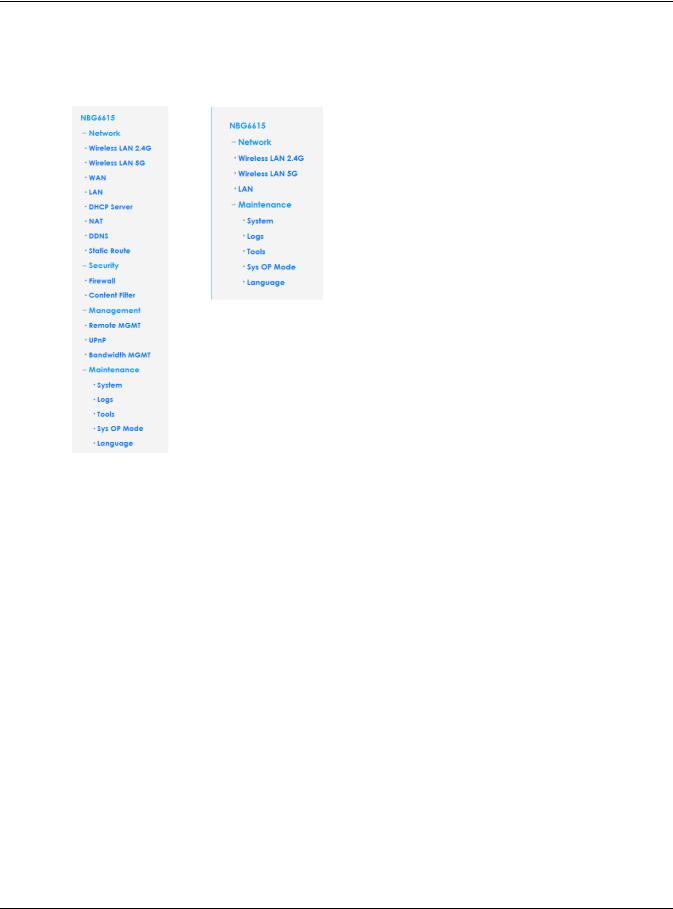
Chapter 1 Introduction
Use a (supported) web browser to manage the NBG6615. Menus vary according to which mode you’re using.
Router Mode |
|
AP Mode |
|
|
|
|
|
|
|
|
|
See Chapter 4 on page 28 for more information on these modes.
1.2 Securing the NBG6615
Do the following things regularly to make the NBG6615 more secure and to manage the NBG6615 more effectively.
•Change the password. Use a password that’s not easy to guess and that consists of different types of characters, such as numbers and letters.
•Write down the password and put it in a safe place.
•Back up the configuration (and make sure you know how to restore it). Restoring an earlier working configuration may be useful if the device becomes unstable or even crashes. If you forget your password, you will have to reset the NBG6615 to its factory default settings. If you backed up an earlier configuration file, you would not have to totally re-configure the NBG6615. You could simply restore your last configuration.
NBG6615’s User’s Guide
12

Chapter 1 Introduction
1.3 LEDs
Figure 2 Front Panel
The following table describes the LEDs and the WPS button.
Table 1 Front Panel LEDs and WPS Button
LED |
COLOR |
STATUS |
DESCRIPTION |
|
|
|
|
POWER |
White |
On |
The NBG6615 is receiving power and functioning properly. |
|
|
|
|
|
|
Off |
The NBG6615 is not receiving power. |
|
|
|
|
|
|
Blinking |
The NBG6615 is upgrading its firmware, restoring its configurations, or |
|
|
|
rebooting its system. |
|
|
|
|
Internet |
White |
On |
An IP connection is available but there is no traffic. |
|
|
|
|
|
|
Blinking |
The NBG6615 is sending/receiving data through the WAN. |
|
|
|
|
|
|
Off |
An IP connection is not available. |
|
|
|
|
WLAN_2.4G |
White |
On |
The NBG6615 is ready but is not sending/receiving data through the |
|
|
|
wireless LAN. |
|
|
|
|
|
|
Blinking |
The NBG6615 is sending/receiving data through the wireless LAN. |
|
|
|
|
|
|
Off |
The wireless LAN is not ready or has failed. |
|
|
|
|
|
Amber |
Blinking |
The NBG6615 is negotiating a WPS connection with a wireless client via |
|
|
|
2.4G. |
|
|
|
|
|
|
Off |
The WPS process is inactive. |
|
|
|
|
|
|
Solid for 5 |
Successful WPS connection. |
|
|
seconds |
|
|
|
|
|
WLAN_5G |
White |
On |
The NBG6615 is ready but is not sending/receiving data through the |
|
|
|
wireless LAN. |
|
|
|
|
|
|
Blinking |
The NBG6615 is sending/receiving data through the wireless LAN. |
|
|
|
|
|
|
Off |
The WPS status is not configured or disabled. |
|
|
|
|
|
Amber |
Blinking |
The NBG6615 is negotiating a WPS connection with a wireless client via |
|
|
|
5G. |
|
|
|
|
|
|
Off |
The WPS process is inactive. |
|
|
|
|
|
|
Solid for 5 |
Successful WPS connection. |
|
|
seconds |
|
|
|
|
|
WPS Button |
|
|
Press to initiate the WPS process. |
|
|
|
|
1.4 The WPS Button
Your NBG6615 supports WiFi Protected Setup (WPS), which is an easy way to set up a secure wireless network. WPS is an industry standard specification, defined by the Wi-Fi Alliance.
NBG6615’s User’s Guide
13

Chapter 1 Introduction
WPS allows you to quickly set up a wireless network with strong security, without having to configure security settings manually. Each WPS connection works between two devices. Both devices must support WPS (check each device’s documentation to make sure).
Depending on the devices you have, you can either press a button (recommended) on the device itself, or in its configuration utility or enter a PIN (a unique Personal Identification Number that allows one device to authenticate the other) in each of the two devices. When WPS is activated on a device, it has two minutes to find another device that also has WPS activated. Then, the two devices connect and set up a secure network by themselves.
The WPS button is located at the front panel of the NBG6615.
1.4.1 Using the WPS Button
1Make sure the power LED is on.
2Press the WPS button within 3 seconds to turn on the WPS function For more information on using WPS, see Section 5.3 on page 39.
1.5Reboot/Reset Button
Your NBG6615 has a recessed reboot/reset button on its back panel. To reboot, press the button with a paper clip or similar object for 3 to 5 seconds. To reset the NBG6615 to factory defaults, press for longer than 10 seconds.
1.6 Wall Mounting
You may need screw anchors if mounting on a concrete or brick wall.
Table 2 Wall Mounting Information
Distance between holes |
10.50 cm |
|
|
M4 Screws |
Two |
|
|
Screw anchors (optional) |
Two |
|
|
Figure 3 Screw Specifications
NBG6615’s User’s Guide
14
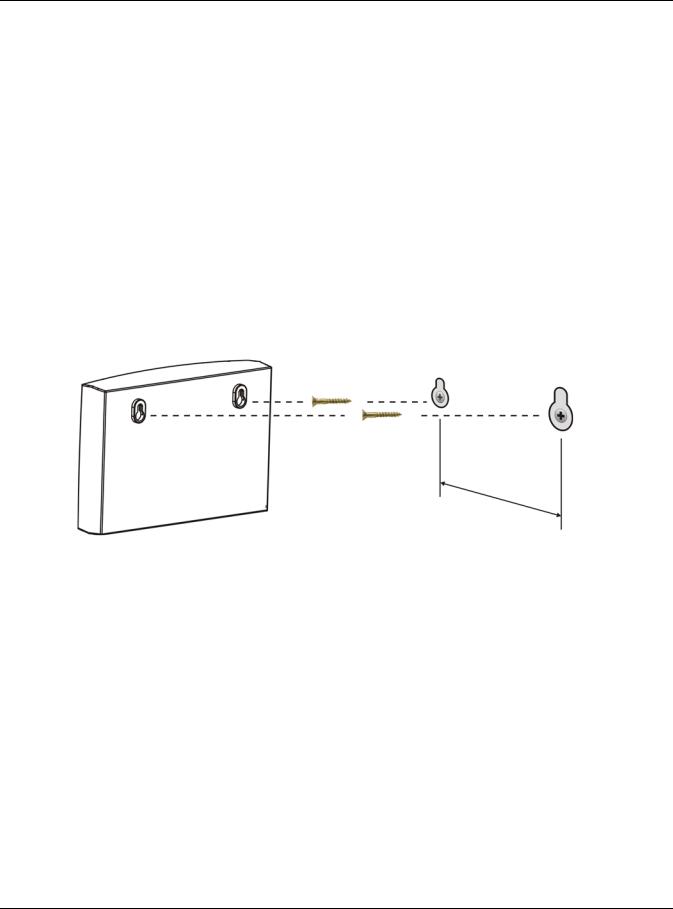
Chapter 1 Introduction
1Select a position free of obstructions on a wall strong enough to hold the weight of the device.
2Mark two holes on the wall at the appropriate distance apart for the screws.
Be careful to avoid damaging pipes or cables located inside the wall when drilling holes for the screws.
3If using screw anchors, drill two holes for the screw anchors into the wall. Push the anchors into the full depth of the holes, then insert the screws into the anchors. Do not insert the screws all the way in - leave a small gap of about 0.5 cm.
If not using screw anchors, use a screwdriver to insert the screws into the wall. Do not insert the screws all the way in - leave a gap of about 0.5 cm.
4Make sure the screws are fastened well enough to hold the weight of the NBG6615 with the connection cables.
5Align the holes on the back of the NBG6615 with the screws on the wall. Hang the NBG6615 on the screws.
Figure 4 Wall Mounting Example
NBG6615’s User’s Guide
15

CHAPTER 2
The Web Configurator
2.1 Overview
This chapter describes how to access the NBG6615 Web Configurator and provides an overview of its screens.
The Web Configurator is an HTML-based management interface that allows easy setup and management of the NBG6615 via Internet browser. Use Internet Explorer 8.0 and later versions, Mozilla Firefox, Google Chrome or Safari. The recommended screen resolution is 1366 by 768 pixels.
In order to use the Web Configurator you need to allow:
•Web browser pop-up windows from your device. Web pop-up blocking is enabled by default in Windows XP SP (Service Pack) 2.
•JavaScript (enabled by default).
•Java permissions (enabled by default).
Refer to Chapter 23 Troubleshooting to see how to make sure these functions are allowed in Internet Explorer.
2.2Accessing the Web Configurator
1Make sure your NBG6615 hardware is properly connected and prepare your computer or computer network to connect to the NBG6615 (refer to the Quick Start Guide).
2Launch your web browser.
3When the NBG6615 is in router mode, type "http://192.168.212.1" as the website address in your web browser. 192.168.212.1 is the default LAN IP address in router mode (the default device mode). (The default IP address in AP mode is 192.168.1.2).
Your computer must be in the same subnet in order to access this website address. In router mode, the NBG6615 can assign your computer an IP address, so you must set your computer to get an IP address automatically (computer factory default) or give it a fixed IP address in the range between 192.168.212.3 and 192.168.212.254 (see Appendix C on page 157).
4Type admin (default) as the user name and 1234 (default) as the password and click OK.
NBG6615’s User’s Guide
16
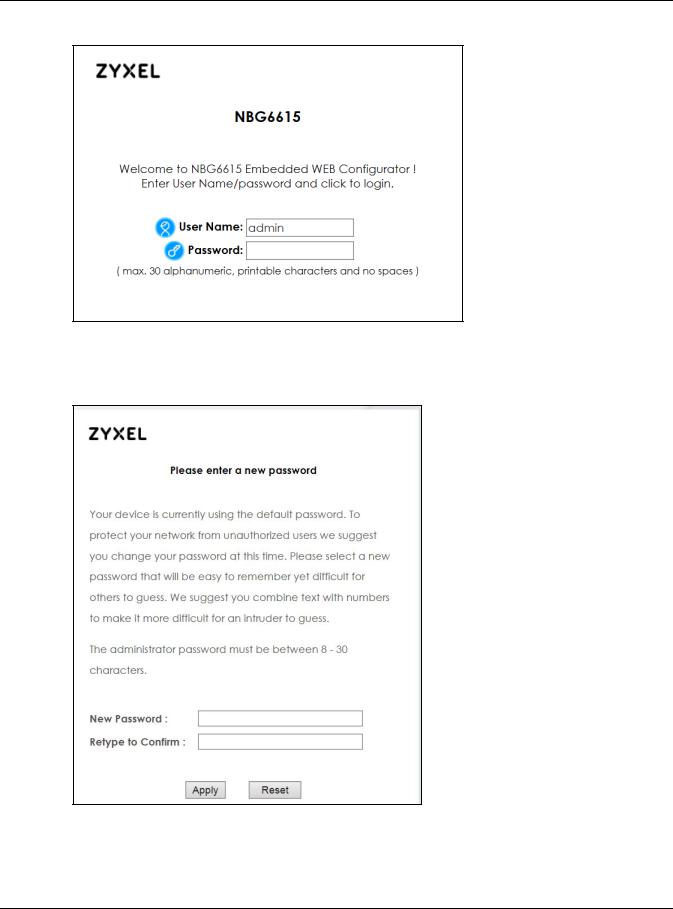
Chapter 2 The Web Configurator
Figure 5 Login Screen
5You should see a screen asking you to change your password (highly recommended) as shown next. Type a new password. Click Apply to save your changes. Click Ignore if you do not want to change the password this time.
Figure 6 Change Password Screen
Note: The management session automatically times out when the time period set in the Administrator Inactivity Timer field expires (default five minutes). Simply log back into the NBG6615 if this happens.
NBG6615’s User’s Guide
17
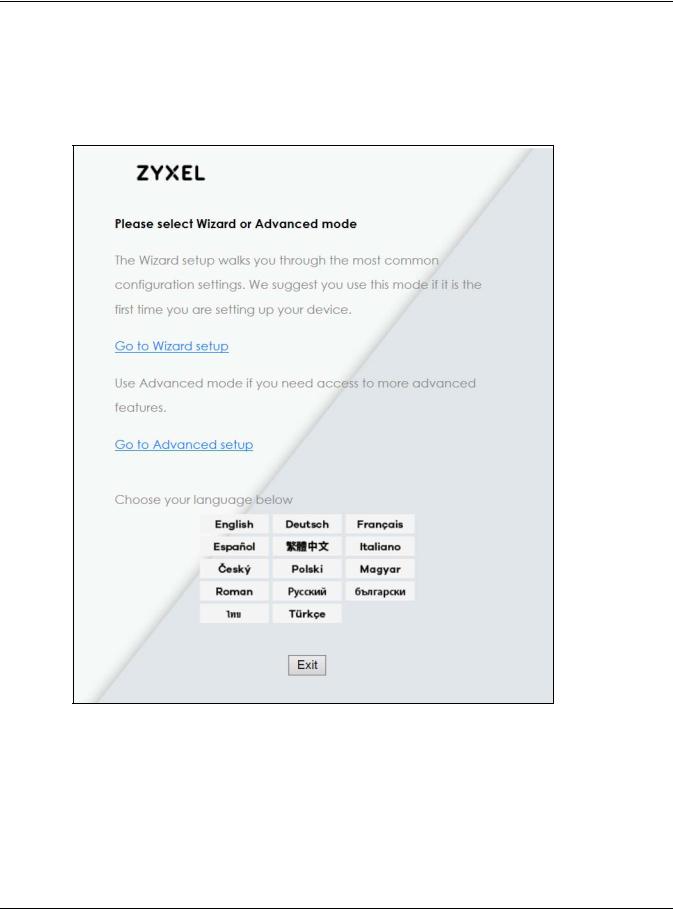
Chapter 2 The Web Configurator
6Select the setup type you want to use.
•Click Go to Wizard Setup to use the Configuration Wizard for basic Internet and Wireless setup.
•Click Go to Advanced Setup to view and configure all the NBG6615’s settings.
•Select a language to go to the basic Web Configurator in that language. To change to the advanced configurator see Chapter 22 on page 132.
Figure 7 Selecting the setup mode
2.3 Resetting the NBG6615
If you forget your password or IP address, or you cannot access the Web Configurator, you will need to use the Reset button at the back of the NBG6615 to reload the factory-default configuration file. This means that you will lose all configurations that you had previously saved, the username will be reset to admin and password will be reset to 1234. The IP address in router mode will be reset to “192.168.212.1”.
NBG6615’s User’s Guide
18

Chapter 2 The Web Configurator
Make sure the power LED is on and press the Reset button for longer than 10 seconds to restart/reboot and set the NBG6615 back to its factory-default configurations.
NBG6615’s User’s Guide
19
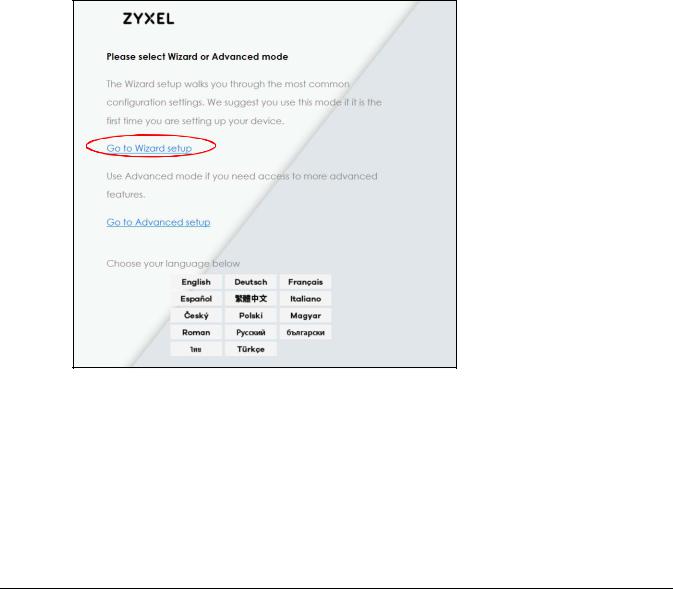
CHAPTER 3
Connection Wizard
3.1 Wizard Setup
This chapter provides information on the Wizard setup screens in the Web Configurator.
The Web Configurator’s Wizard setup helps you configure your device to access the Internet. Leave a field blank if you don’t have that information.
1 After you access the NBG6615 Web Configurator, click Go to Wizard setup.
Use this screen to choose whether you want to use the NBG6615 as a router or an access point. Select Router mode if you want the device to route traffic between a local network and another network such
NBG6615’s User’s Guide
20
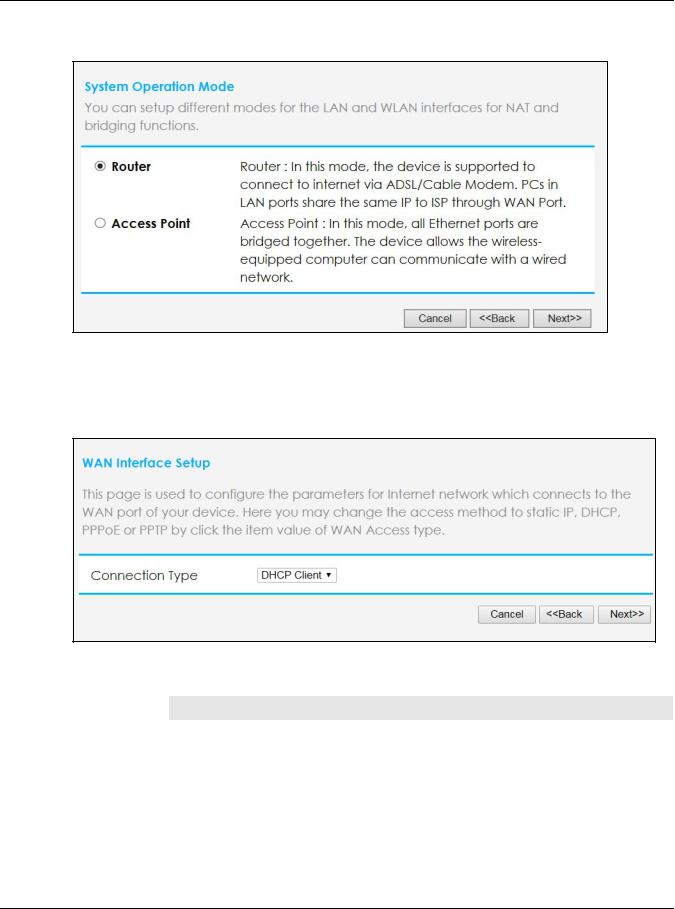
Chapter 3 Connection Wizard
as the Internet. Select Access Point if you want the device to bridge traffic between clients on the same network. Click Next to save your settings.
2On the WAN Interface Setup screen, select an Internet access setting from the drop-down list. The NBG6615 offers four Internet access settings: Static IP, Dynamic Host Configuration Protocol (DHCP Client), PPP over Ethernet (PPPoE), and Point to Point Tunneling Protocol (PPTP). Check with your ISP to make sure you use the correct setting. This Wizard screen varies according to the connection type that you select.
The following table describes the labels on this screen.
Figure 8 WAN Interface Setup
LABEL |
DESCRIPTION |
|
|
Static IP |
Select Static IP if your ISP assigned you a fixed IP address. |
|
|
DHCP Client |
Select DHCP Client if your ISP did not assign you a fixed IP address. |
|
|
PPPoE |
Select PPPoE for a dial-up connection. |
|
|
PPTP |
Select PPTP to set up a virtual private network (VPN) in unsecured TCP/IP environments. |
|
|
Cancel |
Click Cancel to exit the Wizard without saving. |
|
|
Back |
Click Back to return to the previous screen. |
|
|
Next |
Click Next to proceed to the next screen. |
|
|
NBG6615’s User’s Guide
21
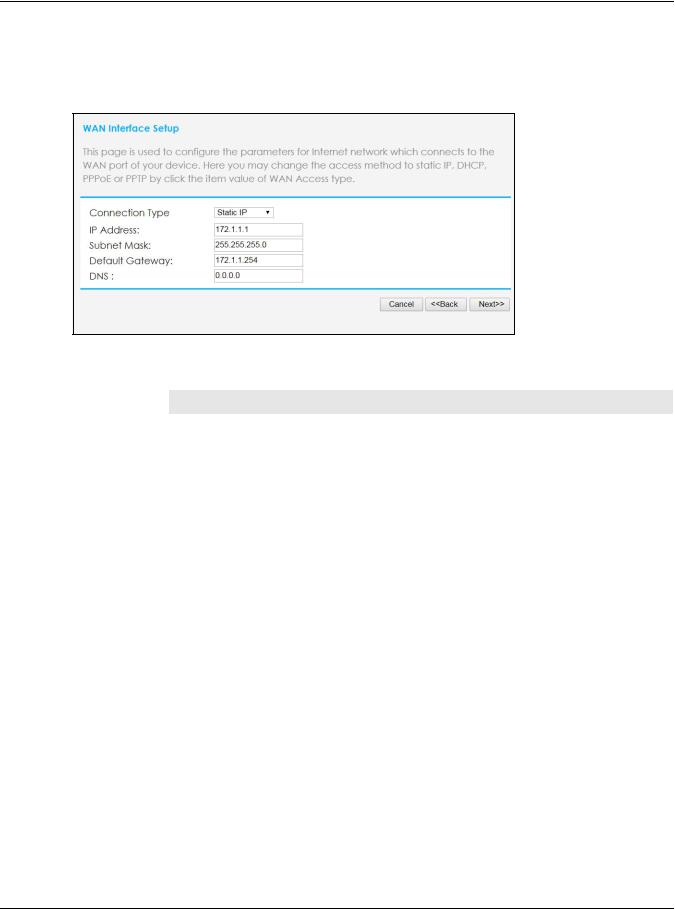
Chapter 3 Connection Wizard
3.1.1 Static IP Connection
The following Wizard screen allows you to assign a fixed IP address to the NBG6615.
Figure 9 Connection Type: Static IP
The following table describes the labels on this screen.
Figure 10 Connection Type: Static IP
LABEL |
DESCRIPTION |
|
|
Connection |
Select Static IP to give the NBG6615 a fixed, unique IP address. |
Type |
|
|
|
IP Address |
Select this option if you were given IP address and/or DNS server settings by the ISP. The fixed IP |
|
address should be in the same subnet as your broadband modem or router. |
|
|
Subnet Mask |
Enter the subnet mask address in this field. |
|
|
Default |
Enter the gateway IP address provided by your ISP. |
Gateway |
|
|
|
DNS |
DNS (Domain Name System) is for mapping a domain name to its corresponding IP address and |
|
vice versa. The DNS server is extremely important because without it, you must know the IP |
|
address of a computer before you can access it. The NBG6615 uses a system DNS server (in the |
|
order you specify here) to resolve domain names for DDNS and the time server. Enter the DNS |
|
server’s IP address in this field. |
|
|
Cancel |
Click Cancel to exit the Wizard without saving. |
|
|
Back |
Click Back to return to the previous screen. |
|
|
Next |
Click Next to proceed to the next screen. |
|
|
3.1.2 DHCP Client
Select DHCP Client when your network administrator or ISP assigns your IP address dynamically. This is a connection type often used with cable modems.
NBG6615’s User’s Guide
22
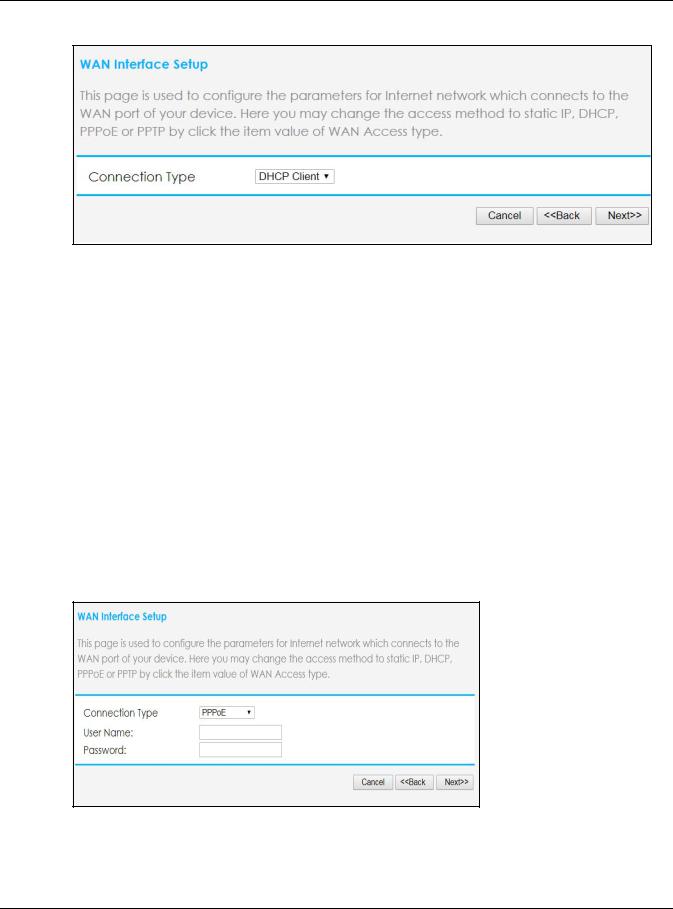
Chapter 3 Connection Wizard
Figure 11 Connection Type: DHCP Client
3.1.3 PPPoE Connection
Point-to-Point Protocol over Ethernet (PPPoE) functions as a dial-up connection. PPPoE is an IETF (Internet Engineering Task Force) standard specifying how a host personal computer interacts with a broadband modem (for example DSL, cable, wireless, etc.) to achieve access to high-speed data networks.
For the service provider, PPPoE offers an access and authentication method that works with existing access control systems (for instance, RADIUS).
One of the benefits of PPPoE is the ability to let end users access one of multiple network services, a function known as dynamic service selection. This enables the service provider to easily create and offer new IP services for specific users.
Operationally, PPPoE saves significant effort for both the subscriber and the ISP/carrier, as it requires no specific configuration of the broadband modem at the subscriber’s site.
By implementing PPPoE directly on the NBG6615 (rather than individual computers), the computers on the LAN do not need PPPoE software installed, since the NBG6615 does that part of the task. Furthermore, with NAT, all of the LAN's computers will have Internet access.
Figure 12 Connection Type: PPPoE
The following table describes the labels on this screen.
NBG6615’s User’s Guide
23
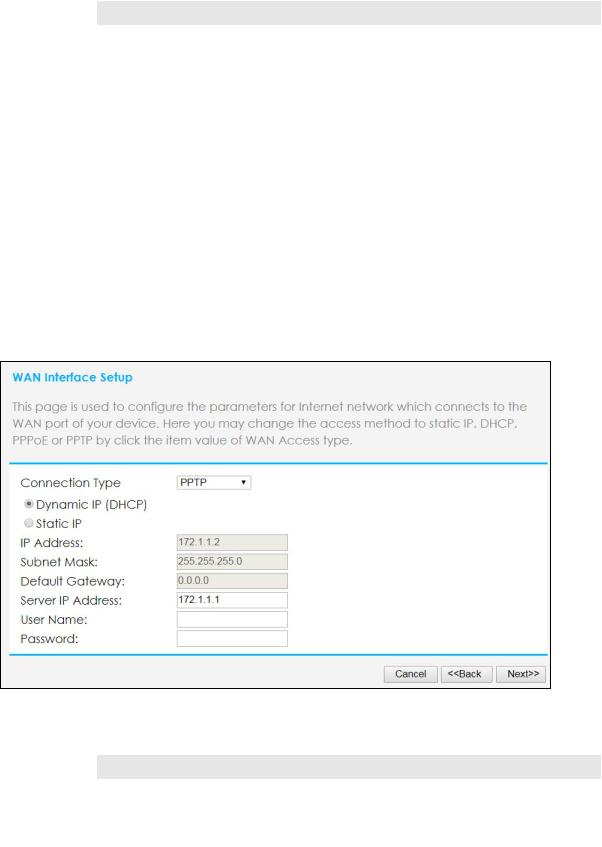
|
|
Chapter 3 Connection Wizard |
|
|
|
|
Table 3 Connection Type: PPPoE |
|
|
|
|
|
LABEL |
DESCRIPTION |
|
|
|
|
Connection |
Select PPPoE for a dial-up connection. |
|
Type |
|
|
|
|
|
User Name |
Type the user name given to you by your ISP. |
|
|
|
|
Password |
Type the password associated with the user name above. |
|
|
|
|
Confirm |
Type the password again for confirmation. |
|
Password |
|
|
|
|
|
Cancel |
Click Cancel to exit the Wizard without saving. |
|
|
|
|
Back |
Click Back to return to the previous screen. |
|
|
|
|
Next |
Click Next to proceed to the next screen. |
|
|
|
3.1.4 PPTP Connection
Point-to-Point Tunneling Protocol (PPTP) is a network protocol that enables secure transfer of data from a remote client to a private server, creating a Virtual Private Network (VPN) using TCP/IP-based networks.
PPTP supports on-demand, multi-protocol and virtual private networking over public networks, such as the Internet.
Figure 13 Connection Type: PPTP
The following table describes the labels on this screen.
Table 4 Connection Type: PPTP
|
LABEL |
DESCRIPTION |
|
|
|
|
Connection |
Select PPTP from the drop-down list box. Select Dynamic IP (DHCP) if your ISP dynamically assigns |
|
Type |
DNS server information (and the NBG6615’s WAN IP address). Cick Static IP if you have the IP |
|
|
address of a DNS server |
|
|
|
|
IP Address |
If you selected Static IP, type the static IP address assigned to you by your ISP. |
|
|
|
|
|
|
|
|
NBG6615’s User’s Guide |
24
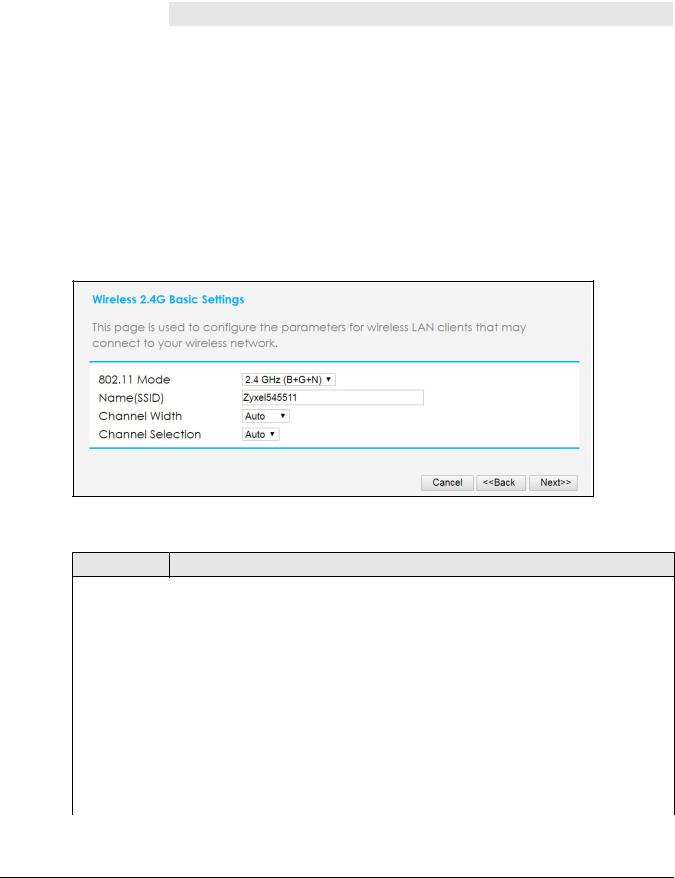
|
|
Chapter 3 Connection Wizard |
|
|
|
|
|
|
|
LABEL |
DESCRIPTION |
|
|
|
|
Subnet Mask |
If you selected Static IP, enter the subnet mask address assigned to you by your ISP (if given). |
|
|
|
|
Default |
If you selected Static IP, enter the gateway IP address of the PPTP server. |
|
Gateway |
|
|
|
|
|
Server IP |
Type the IP address of the PPTP server. |
|
Address |
|
|
|
|
|
User Name |
Type the user name given to you by your ISP. |
|
|
|
|
Password |
Type the password associated with the user name above. |
|
|
|
|
Cancel |
Click Cancel to exit the Wizard without saving. |
|
|
|
|
Back |
Click Back to return to the previous screen. |
|
|
|
|
Next |
Click Next to proceed to the next screen. |
|
|
|
3You can now set up the wireless LAN. Use this screen to configure the basic settings of the wireless 2.4G band.
Figure 14 Wireless 2.4GSettings
The following table describes the labels on this screen.
Table 5 Wireless Settings
LABEL DESCRIPTION
Wireless 2.4G Basic Settings
802.11 Mode |
Select the IEEE 802.11 WLAN mode you wish to use on the NBG6615 from the drop-down list. |
|
|
Name (SSID) |
Enter a descriptive name (up to 32 printable 7-bit ASCII characters) for the wireless LAN. |
|
If you change this field on the NBG6615, make sure all wireless stations use the same SSID in order |
|
to access the network. |
|
|
Channel Width |
Select whether the NBG6615 uses a wireless channel width of 20MHz, 40MHz, or 80 MHz |
|
(available with 5G only). Select Auto to allow the NBG6615 to adjust the channel bandwidth |
|
depending on network conditions. |
|
Select 20 MHz if you want to lessen radio interference with other wireless devices in your |
|
neighborhood or the wireless clients do not support channel bonding. |
|
Select 40 MHz if your 2.4G to bond two adjacent radio channels to increase throughput. The |
|
wireless clients must also support 40 MHz. |
|
Select 80MHz (available for 5G only) if you have a network with only a few wireless clients. |
|
|
NBG6615’s User’s Guide
25

|
|
|
Chapter 3 Connection Wizard |
|
|
|
|
|
Table 5 |
Wireless Settings |
|
|
LABEL |
|
DESCRIPTION |
|
|
|
|
|
Channel |
|
The range of radio frequencies used by IEEE 802.11b/g/n wireless devices is called a channel. |
|
Selection |
Set the operating frequency/channel depending on your particular region. Select a channel |
|
|
|
|
|
|
|
|
from the drop-down list box. The options vary depending on the frequency band and the |
|
|
|
country you are in. |
|
|
|
Select Auto to have the NBG6615 automatically choose the channel with the least interference. |
|
|
|
|
|
Cancel |
|
Click Cancel to close the Wizard screen without saving. |
|
|
|
|
|
Back |
|
Click Back to display the previous screen. |
|
|
|
|
|
Next |
|
Click Next to proceed to the next screen. |
|
|
|
|
4Next, select whether you want to use encryption to protect the information sent through the wireless network. In the drop-down list, you can choose None, WPA2-PSK, and WPA-PSK/WPA2-PSK. WPA2-PSK is currently the strongest form of security and is recommended for all uses. If you have older devices that don't support WPA2-PSK, select WPA-PSK/WPA2-PSK, which allows newer devices to use WPA2-PSK and legacy devices to use WPA-PSK. If you select an encryption protocol, create a password in the Preshared Key field. The password can be 8 to 63 case-sensitive ASCII characters (including spaces and symbols) or 64 hexadecimal characters (“0-9,” “A-F”). Click Next to save the settings.
5 Repeat steps 4 and 5 to set up the wireless 5G.
NBG6615’s User’s Guide
26
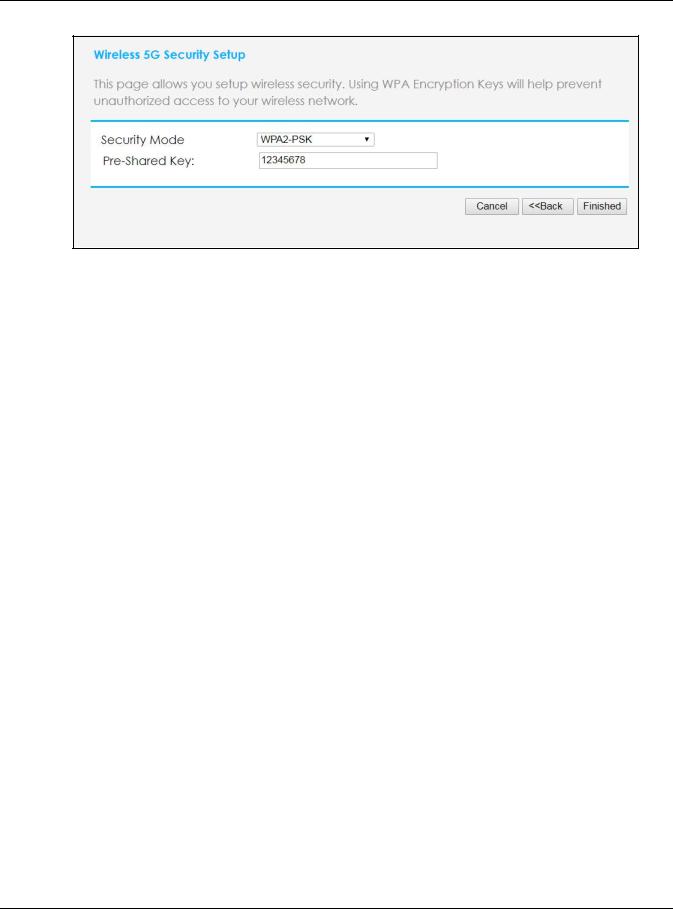
Chapter 3 Connection Wizard
6Click Finished to complete the Wizard setup.
Well done! You have successfully set up your NBG6615 to operate on your network and access the Internet.
NBG6615’s User’s Guide
27
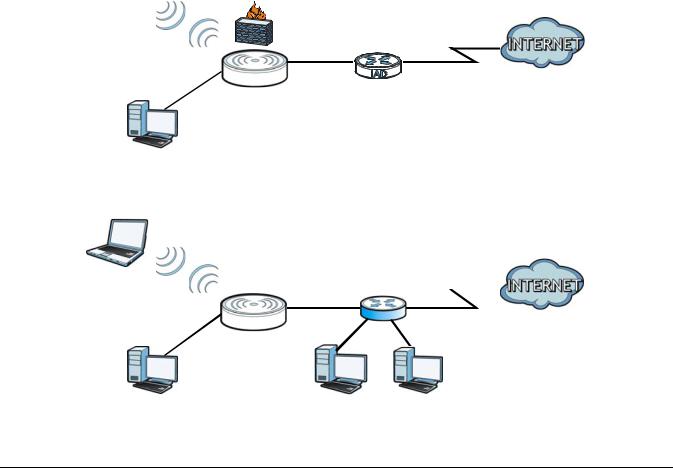
CHAPTER 4
Modes
4.1 Overview
You can set up the NBG6615 with other IEEE 802.11b/g/n compatible devices in different device modes.
Note: Choose your device mode carefully to avoid having to change it later. The NBG6615 automatically restarts when you change modes.
The default LAN IP address of the NBG6615 in Router mode is 192.168.212.1. The default IP address of the NBG6615 in Access Point mode is 192.168.1.2.
•Router: Use this mode if you want to use routing functions such as LAN DHCP, NAT, firewall and so on, on the NBG6615 (N). The NBG6615 has separate LAN and WAN network IP addresses. Connect the WAN port to an Internet Access Device (IAD) such as a broadband modem.
Figure 15 Router
 WLAN
WLAN
WAN IAD
LAN
N
•Access Point: Use this mode if you already have a Router (R) in your network and you want to set up a wireless network and bridge the wired and wireless connections on the NBG6615.
Figure 16 AP Mode
WLAN
N |
R WAN |
||
|
|
|
|
|
|
|
|
LAN
NBG6615’s User’s Guide
28

Chapter 4 Modes
4.2 Setting your NBG6615 to Router Mode
The NBG6615 is set to wireless router mode by default. If it was changed and now you want to set it back, do the following procedure.
1Connect your computer to the LAN port of the NBG6615.
2The default LAN IP address of the NBG6615 is 192.168.212.1 in router mode and 192.168.1.2 by default in Access Point mode. In router mode, the NBG6615 can assign your computer an IP address, so you must set your computer to get an IP address automatically (computer factory default) or give it a fixed IP address in the range between 192.168.212.3 and 192.168.212.254.
3After you’ve set your computer’s IP address, open a web browser such as Internet Explorer and type the IP address of the NBG6615 as the web address in your web browser.
4Log into the Web Configurator. See the Chapter 2 on page 16 for instructions on how to do this.
5Go to Maintenance > Sys OP Mode > General and select Router.
6Click Apply.
Note: Wait while the NBG6615 restarts, then log in to the Web Configurator again. The NBG6615 IP address is now 192.168.212.1.
4.2.1Status Screen (Router Mode)
The screen below shows the status screen in Router mode.
NBG6615’s User’s Guide
29
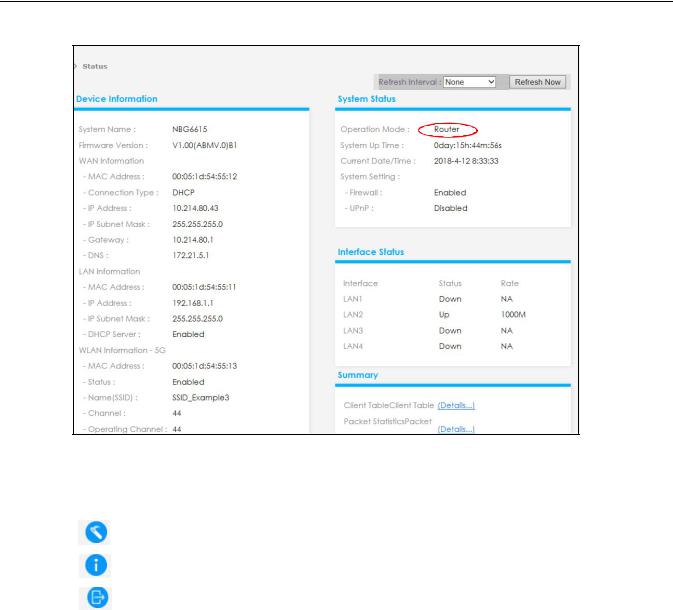
Chapter 4 Modes
Figure 17 Status Screen (Router Mode)
The following table describes the icons shown in the Status screen.
Table 6 Status Screen Icon Key
ICON |
DESCRIPTION |
|
|
|
Click this icon to open the setup wizard. |
|
|
|
Click this icon to view copyright and a link for related product information. |
|
|
|
Click this icon at any time to exit the Web Configurator. |
|
|
The following table describes the labels shown in the Status screen in Router mode.
Table 7 Web Configurator Status Screen (Router Mode)
|
LABEL |
DESCRIPTION |
|
|
|
|
Device Information |
|
|
|
|
|
System Name |
This is the System Name you enter in the Maintenance > System > General screen. |
|
|
It is for identification purposes. |
|
|
|
|
Firmware Version |
This is the current firmware version of the NBG6615. |
|
|
|
|
WAN Information |
|
|
|
|
|
- MAC Address |
This shows the WAN Ethernet adapter MAC Address of your device. |
|
|
|
|
- Connection Type |
This shows the current connection type. |
|
|
|
|
- IP Address |
This shows the WAN port’s IP address. |
|
|
|
|
- IP Subnet Mask |
This shows the WAN port’s subnet mask. |
|
|
|
|
- Gateway |
This shows the WAN port’s gateway IP address. |
|
|
|
|
|
|
|
|
NBG6615’s User’s Guide |
30
